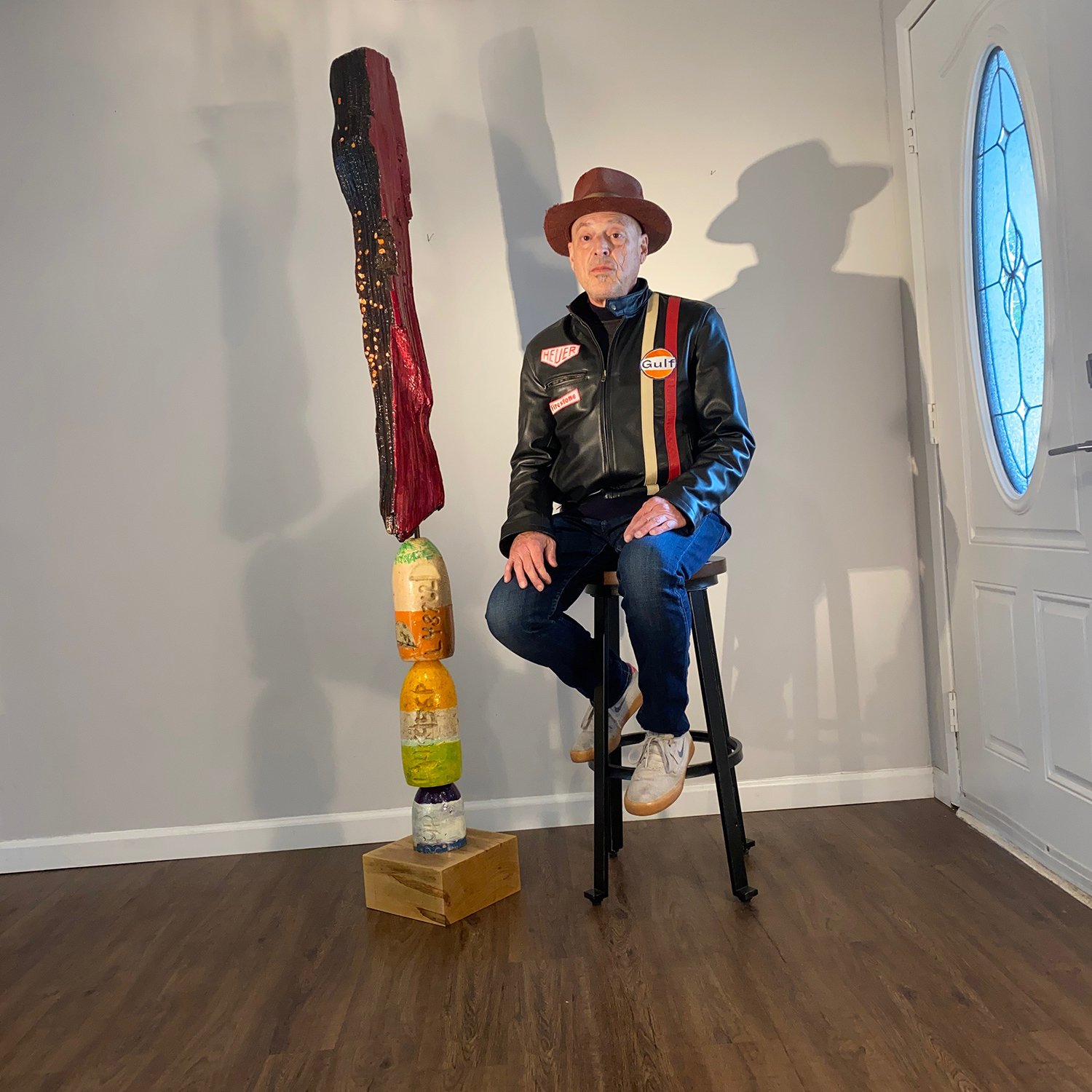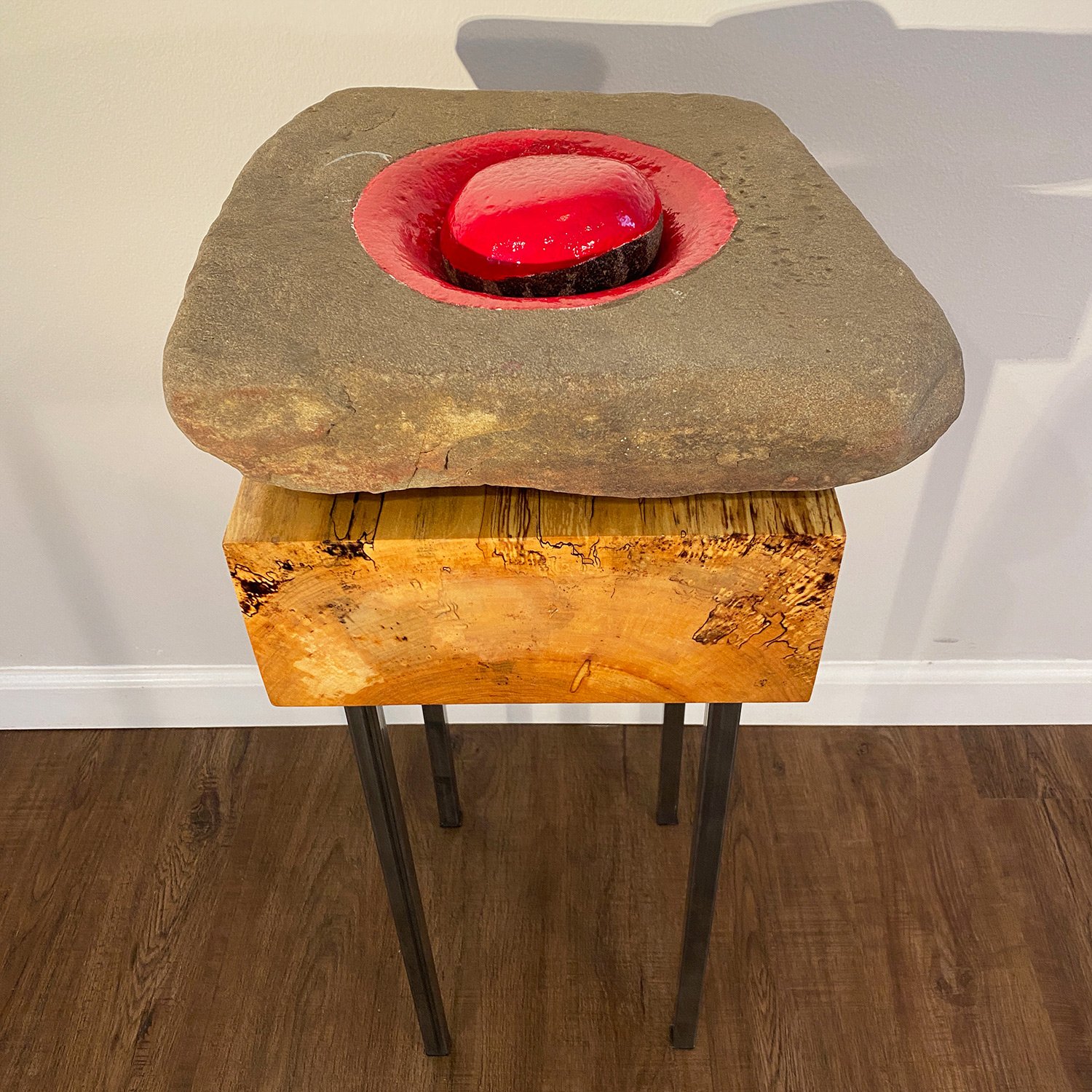Soul Kitchen 2022
Soul Kitchen is a new series of floor pieces. These works employ foundational materials such as steel, stone, and wood to create minimal forms about lightness and weight. Here, all elements possess a symbolic relevance, such as the stone’s the earth hurtling through space at speed while we experience stillness. Solid blocks of hard-woods, which spring from the earth (stone), represent the state of being grounded. The steel, the result of heated minerals, adds both strength and lightness.
Using found artifacts and upgrading them, damaged bits are highlighted and ‘repaired’ in red, emphasizing wounds and healing. There’s also the collaborative component of working with old, discarded relics shaped by other hands, and making them new again, though changed. The materials conflate time. We are part of everything.
The palette of stone, wood, steel, white and red links the concept and the objects.
The pedestal’s part of the piece. Somehow we’re supposed to pretend pedestals, those blocky white boxes that present objects, are invisible. Seriously? That’s a mass formation psychosis! Willful blindness. Ideally the context fits the piece. Further, installation is part of the process.
An antidote to flamboyant palettes and trending figuration. A tight, meditative capsule.
SAS
Studio Install
2022, Los Angeles, California
On The Recent Work of Steve Sas Schwartz
by Mat Gleason, April 2022
The lockdown and subsequent pandemic fallout did not slow down the artistic output of Steven Allan Schwartz aka SAS. Two of his recent series epitomize his tendency to fall into an authentic space of expression. His art ties together impulses the culture at large is feeling long before others can articulate where we are going. From the look of it, SAS is telling us in two recent series that the ordinary object could at any time be a praiseworthy relic worthy of our adoration and one that embodies the emotive space where any break from its place in the natural order is a cause for mourning. After what the world collectively went through in 2020 and 2021, SAS seems to be placing a collective faith in random things as a way of sanctifying the most mundane of our daily activities. Forget these ordinary things and we lose connectivity to the world’s wider consciousness.
Soul Kitchen Series, 2022
Not content with making art influenced solely by the European canon, SAS has recently turned his attention to his “Soul Kitchen” series that uses the Japanese tradition of Kintsugi as a point of departure. Kintsugi is the Japanese art of repairing cracked pottery by mending the areas of breakage with lacquer mixed with powdered gold. The result is a more beautiful functional object, proud of its scars, inspiring the user to be more resilient and accept life’s breakages as irreplaceable beautiful lessons. SAS is an artist demonstrably capable of creating beauty but he never sacrifices the authentic for the superficially pretty. In “Soul Kitchen” he adds a blood red to broken stone objects to remind the viewer of the true cost of breakage, be it heads, hearts or functional objects. Raw emotion exists in a simple, brilliant color application here, making a Kintsugi-like beauty in the abject shock and horror of tragedy.
These altered objects, with their accidental breakage celebrated as a sacrifice to remind us of our mortality, are displayed on exquisite wood pedestals supported by sleek and strong steel legs. These three basic elements of life on earth - stone, wood, steel - are joined by the evidence of the eternal human in the form of the applied paint. The intent of the living is to make their mark, post their commentary, bring a concept and emotion to a tangible place - all of these desires are a striving to make something as long-lasting on the part of humanity as the other three elements in the work.
After what the world went through we can look to the art made in the pandemic’s wake for guidance. While some artists are drawn to the topical, artists in the pedigree of Duchamp, Cadere and Gene Davis push the known with intuitive reflections of our times… finding artists like them and SAS is finding a beacon of where we have been and where we are going. SAS delivers meditations on the nature of our relationship to material things - readymades ready to be immortalized as art. Coming at this sensitive time in recent history, we are given art that posits our relationship with everyday objects as a valid immersion in the sacred.
Slain
©2021, approx. 48” x 10” x 10”, nitrocellulose, stone, walnut, steel.
Pillar
©2021, roughly 77 1/2” x 10” x 10”, nitrocellulose, wood, styrofoam, acrylic.
This totem repurposes materials into something other, a celebration of agency. An 1870's era fence post found around Reno, barbed wired, shotgun blasted, then upgraded, highlighted, and repurposed as art. The piece marks division, separation, and progress of sorts. A novel signpost.
Metate I
©2021, roughly 50 1/2" x 16” x 13", nitrocellulose, stone, solid walnut base, steel spindles.
The stone in this piece is a metate, ('meh-ta-tay' — Native American grinding bowl/mortar and pestle) was broken, and though antique, considered worthless. In the spirit of Kintsugi, the Japanese technique of salvaging broken crockery by pasting shards together with gold leaf, I’ve sought to save the peace and metaphorically mend while acknowledging the wound, thereby marking history, restoring value.
Many associations abound with this piece, including the regenerative and erotic aspect of food preparation. The origin of the word pestle is from Latin, pistillum, meaning "pounder," witch brings its own associations.
Convex, concave, the broken wounds like slabs of meat or lungs, the vulnerability behind the flesh.
Metate II
©2021, roughly 29” x 14” x 13”, nitrocellulose, stone, solid spalted maple, steel.
Gouge
©2021, roughly 48” x 17 1/2” x 27 1/4”, nitrocellulose, Indonesian clam, solid walnut base, steel spindles.
Offering Container
©2021, 28” x 8” x 8”, nitrocellulose on cast iron, solid African mahogany base, steel spindles..
Bloody Hand, #3 of an edition of seven
2022, 49 1/4” x 8” x 8”, nitrocellulose on porcelain glove mold, Shinko, Japan, right hand, circa 2005, solid cherry cube, copper spindles



































